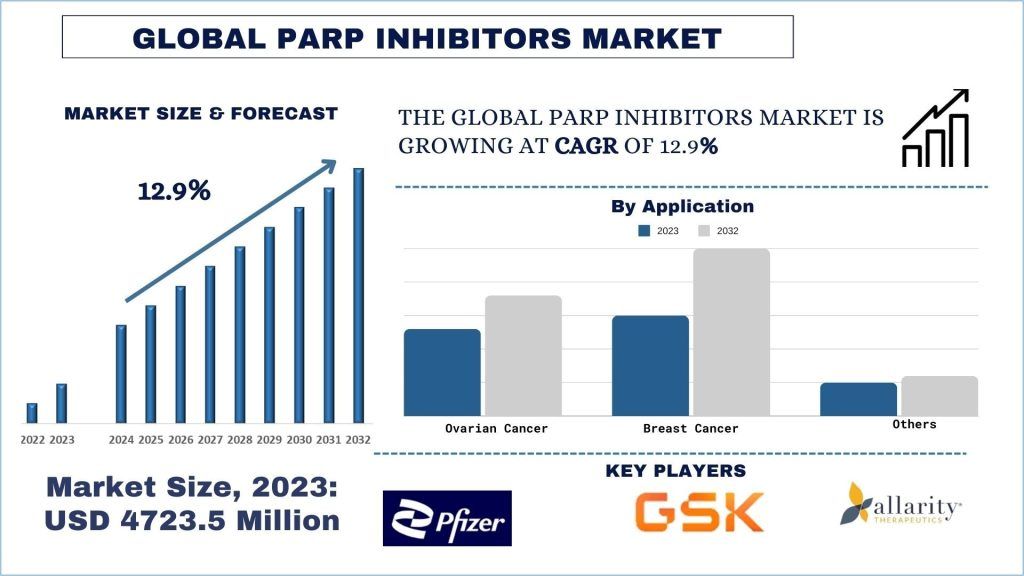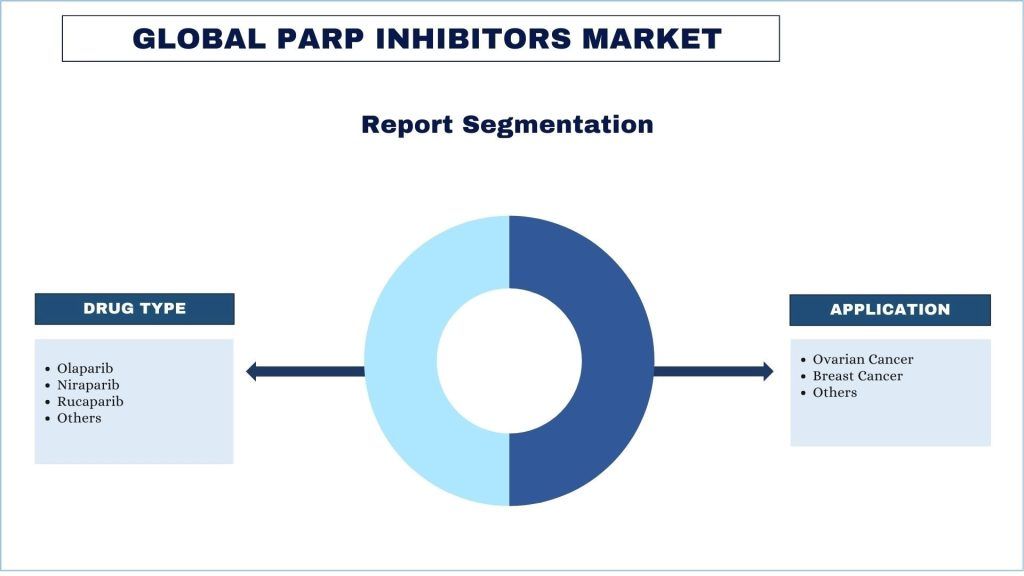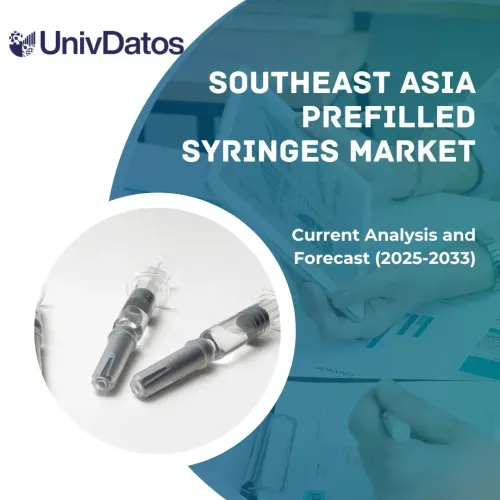- Home
- About Us
- Industry
- Services
- Reading
- Contact Us
PARP Inhibitors Market: Current Analysis and Forecast (2024-2032)
Emphasis on Drug Type (Olaparib, Niraparib, Rucaparib, and Others); Application (Ovarian Cancer, Breast Cancer, and Others); Region/Country
 PARP Inhibitors Market Size & Forecast
PARP Inhibitors Market Size & Forecast
The PARP inhibitors market was valued at USD 4723.5 Million and is expected to grow at a strong CAGR of around 12.9% during the forecast period (2024-2032) owing to investment in PARP inhibitors.
PARP Inhibitors Market Analysis
The PARP inhibitors market has grown significantly due to the increasing incidence of cancers, particularly those with BRCA mutations. PARP inhibitors, such as olaparib and niraparib, are vital in treating ovarian, breast, and prostate cancers. The global aging population and advancements in personalized medicine further drive market expansion. According to the National Cancer Institute, the U.S. alone is projected to see its cancer survivor population increase from 18.1 million in 2022 to 22.5 million by 2032, underscoring the need for effective treatments.
In March 2024, GSK received FDA approval for Zejula (niraparib) as a first-line maintenance treatment for platinum-responsive advanced ovarian cancer.
In February 2024, AbbVie acquired ImmunoGen, including its investigational PARP inhibitor assets aimed at treating ovarian and other solid tumors. This acquisition enhances AbbVie’s oncology portfolio and strategic positioning in the PARP inhibitor market.

PARP Inhibitors Market Trends
This section discusses the key market trends that are influencing the various segments of the PARP Inhibitors Market as identified by our team of research experts.
Olaparib Segment Transforming Industry
Olaparib, marketed under the brand name Lynparza, is a pioneering PARP inhibitor developed by AstraZeneca in collaboration with Merck & Co. It has been a breakthrough in the treatment of various cancers, particularly those associated with BRCA1 and BRCA2 mutations. Initially approved by the FDA in 2014 for the treatment of advanced ovarian cancer, Olaparib has since expanded its indications to include breast, pancreatic, and prostate cancers. As one of the first PARP inhibitors to receive regulatory approval, Olaparib has set the benchmark for other PARP inhibitors. Its success has paved the way for further research and development in the field, encouraging other pharmaceutical companies to explore PARP inhibition as a viable cancer treatment strategy.
North America is Expected to Grow with Significant CAGR During Forecast Period
The North American PARP inhibitors market is a significant segment within the global oncology treatment landscape, driven by a high prevalence of cancers such as ovarian, breast, and prostate cancers. The U.S. leads the market due to its advanced healthcare infrastructure, significant research and development (R&D) investments, and favorable regulatory environment. In 2024, the PARP inhibitors market in North America is projected to continue its robust growth, driven by both established treatments and emerging therapies. For instance, in 2023, US FDA approved the combination of enzalutamide (Xtandi) and talazoparib (Talzenna) as an initial therapy for metastatic castration-resistant prostate cancer.

PARP Inhibitors Industry Overview
The PARP inhibitors market is competitive and fragmented, with the presence of several global and international market players. The key players are adopting different growth strategies to enhance their market presence, such as partnerships, agreements, collaborations, new product launches, geographical expansions, and mergers and acquisitions. Some of the major players operating in the market are AstraZeneca; Pfizer Inc.; Clovis Oncology, Inc.; Johnson & Johnson; Bristol Myers Squibb; AbbVie Inc. ; Artios Pharma; Merck kGaA; Allarity Therapeutics, Inc.; and GlaxoSmithKline.
PARP Inhibitors Market News
In December 2023, GSK completed the acquisition of Tesaro, a company known for its PARP inhibitor, Niraparib (Zejula). This acquisition is part of GSK’s strategy to strengthen its oncology pipeline and expand its market presence in cancer therapeutics.
In November 2023, AstraZeneca and Daiichi Sankyo announced a collaboration to co-develop and commercialize a new PARP inhibitor for various cancer types. This partnership aims to combine their respective strengths in oncology research and development to bring innovative treatments to the market.
PARP Inhibitors Market Report Coverage
Report Attribute | Details |
Base year | 2023 |
Forecast period | 2024-2032 |
Growth momentum | Accelerate at a CAGR of 12.9% |
Market size 2023 | USD 4723.5 Million |
Regional analysis | North America, Europe, APAC, Rest of the World |
Major contributing region | Asia-Pacific is expected to grow at the highest CAGR during the forecasted period |
Key countries covered | U.S., Canada, Germany, United Kingdom, Spain, Italy, France, China, Japan, and India |
Companies profiled | AstraZeneca; Pfizer Inc.; Clovis Oncology, Inc.; Johnson & Johnson; Bristol Myers Squibb; AbbVie Inc.; Artios Pharma; Merck kGaA; Allarity Therapeutics, Inc.; and GlaxoSmithKline. |
Report Scope | Market Trends, Drivers, and Restraints; Revenue Estimation and Forecast; Segmentation Analysis; Demand and Supply Side Analysis; Competitive Landscape; Company Profiling |
Segments Covered | By Drug Type; By Application; By Region/Country |
Reasons to buy this report:
- The study includes market sizing and forecasting analysis validated by authenticated key industry experts.
- The report presents a quick review of overall industry performance at one glance.
- The report covers an in-depth analysis of prominent industry peers with a primary focus on key business financials, product portfolios, expansion strategies, and recent developments.
- Detailed examination of drivers, restraints, key trends, and opportunities prevailing in the industry.
- The study comprehensively covers the market across different segments.
- Deep dive regional level analysis of the industry.
Customization Options:
The global PARP inhibitors market can further be customized as per the requirement or any other market segment. Besides this, UMI understands that you may have your own business needs, hence feel free to connect with us to get a report that completely suits your requirements.
Table of Content
Research Methodology for the PARP Inhibitors Market Analysis (2024-2032)
Analyzing the historical market, estimating the current market, and forecasting the future market of the global PARP inhibitors market were the three major steps undertaken to create and analyze the adoption of PARP inhibitors in major regions globally. Exhaustive secondary research was conducted to collect the historical market numbers and estimate the current market size. Secondly, to validate these insights, numerous findings and assumptions were taken into consideration. Moreover, exhaustive primary interviews were also conducted, with industry experts across the value chain of the global PARP inhibitors market. Post assumption and validation of market numbers through primary interviews, we employed a top-down/bottom-up approach to forecasting the complete market size. Thereafter, market breakdown and data triangulation methods were adopted to estimate and analyze the market size of segments and sub-segments of the industry pertains to. Detailed methodology is explained below:
Analysis of Historical Market Size
Step 1: In-Depth Study of Secondary Sources:
Detail secondary study was conducted to obtain the historical market size of the PARP inhibitors market through company internal sources such as annual reports & financial statements, performance presentations, press releases, etc., and external sources including journals, news & articles, government publications, competitor publications, sector reports, third-party database, and other credible publications.
Step 2: Market Segmentation:
After obtaining the historical market size of the PARP inhibitors market, we conducted a detailed secondary analysis to gather historical market insights and share for different segments & sub-segments for major regions. Major segments are included in the report as drug type and application. Further country-level analyses were conducted to evaluate the overall adoption of testing models in that region.
Step 3: Factor Analysis:
After acquiring the historical market size of different segments and sub-segments, we conducted a detailed factor analysis to estimate the current market size of the PARP inhibitors market. Further, we conducted factor analysis using dependent and independent variables such as drug type and application of the PARP inhibitors market. A thorough analysis was conducted for demand and supply-side scenarios considering top partnerships, mergers and acquisitions, business expansion, and product launches in the PARP inhibitors market sector across the globe.
Current Market Size Estimate & Forecast
Current Market Sizing: Based on actionable insights from the above 3 steps, we arrived at the current market size, key players in the global PARP inhibitors market, and market shares of the segments. All the required percentage shares split, and market breakdowns were determined using the above-mentioned secondary approach and were verified through primary interviews.
Estimation & Forecasting: For market estimation and forecast, weights were assigned to different factors including drivers & trends, restraints, and opportunities available for the stakeholders. After analyzing these factors, relevant forecasting techniques i.e., the top-down/bottom-up approach were applied to arrive at the market forecast for 2032 for different segments and sub-segments across the major markets globally. The research methodology adopted to estimate the market size encompasses:
- The industry’s market size, in terms of revenue (USD) and the adoption rate of the PARP inhibitors market across the major markets domestically
- All percentage shares, splits, and breakdowns of market segments and sub-segments
- Key players in the global PARP inhibitors market in terms of products offered. Also, the growth strategies adopted by these players to compete in the fast-growing market
Market Size and Share Validation
Primary Research: In-depth interviews were conducted with the Key Opinion Leaders (KOLs) including Top Level Executives (CXO/VPs, Sales Head, Marketing Head, Operational Head, Regional Head, Country Head, etc.) across major regions. Primary research findings were then summarized, and statistical analysis was performed to prove the stated hypothesis. Inputs from primary research were consolidated with secondary findings, hence turning information into actionable insights.
Split of Primary Participants in Different Regions

Market Engineering
The data triangulation technique was employed to complete the overall market estimation and to arrive at precise statistical numbers for each segment and sub-segment of the global PARP inhibitors market. Data was split into several segments & sub-segments post studying various parameters and trends in the areas of the drug type and application in the global PARP inhibitors market.
The main objective of the Global PARP Inhibitors Market Study
The current & future market trends of the global PARP inhibitors market were pinpointed in the study. Investors can gain strategic insights to base their discretion for investments on the qualitative and quantitative analysis performed in the study. Current and future market trends determined the overall attractiveness of the market at a regional level, providing a platform for the industrial participant to exploit the untapped market to benefit from a first-mover advantage. Other quantitative goals of the studies include:
- Analyze the current and forecast market size of the PARP inhibitors market in terms of value (USD). Also, analyze the current and forecast market size of different segments and sub-segments.
- Segments in the study include areas of the drug type and application.
- Define and analysis of the regulatory framework for the PARP inhibitors
- Analyze the value chain involved with the presence of various intermediaries, along with analyzing customer and competitor behaviors of the industry.
- Analyze the current and forecast market size of the PARP inhibitors market for the major region.
- Major countries of regions studied in the report include Asia Pacific, Europe, North America, and the Rest of the World
- Company profiles of the PARP inhibitors market and the growth strategies adopted by the market players to sustain in the fast-growing market
- Deep dive regional level analysis of the industry
Frequently Asked Questions FAQs
Q1: What is the current market size and growth potential of the PARP inhibitors market?
Q2: What are the driving factors for the growth of the PARP inhibitors market?
Q3: Which segment has the largest share of the PARP inhibitors market by application?
Q4: What are the emerging technologies and trends in the PARP inhibitors market?
Q5: Which region will dominate the PARP inhibitors market?
Related Reports
Customers who bought this item also bought










